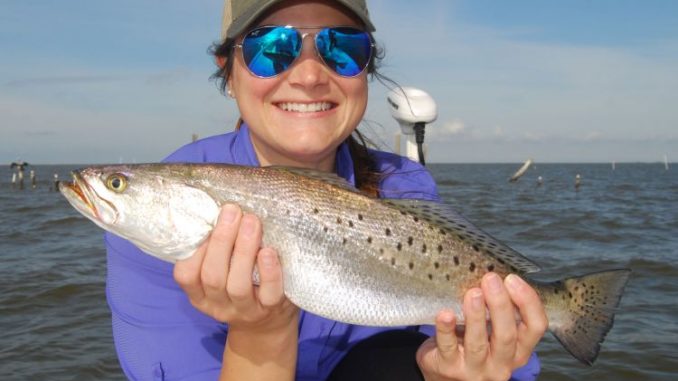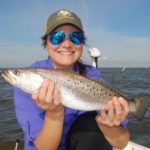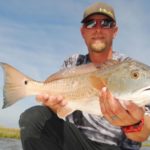
But rising river means trout will be heading to more traditional summer spots, guide says
Since April 1, the Mississippi River at New Orleans has been steadily rising, with the Carrolton gage moving from about 6 feet up to 9 ½ feet today.
And it’s not done yet — the river is predicted to crest at about 10 ½ feet nine days from now.
Capt. Cody Obiol is keeping a close eye on The Big Muddy because of the effect the rising water has on the speckled trout bite on both sides of the river out of Buras — and how long his boat rides with clients will be each morning to get on the fish.
“As the river comes up, the fish will stay there as long as the fresh water doesn’t push in,” said Obiol, who guides for Cajun Fishing Adventures in Buras. “But what usually happens is you get an algae bloom after the river water gets in there, and that’s when all the fish will leave. On the west side, they’re going to head to Four Bayous and Grand Isle and push that way.
“On the east side, closer to the river, as it comes up it’s going to push them out into areas between freshwater spots where saltwater gets trapped — like on the back side of points, off rigs, in the outer bays and at the Iron Banks and Stone Island. It’s going to push the fish out to those spots, versus being close to the river where they are now.”
But despite the rising water, both speckled trout and redfish have been pretty plentiful so far this spring, and that trend continued on a trip Wednesday in Bastian Bay on the west side with Obiol and Erin Brown of Vanishing Paradise.
Solid specks came aboard pretty consistently early on live shrimp under a popping cork — until the wind kicked up late in the morning and dirtied the water. But redfish weren’t a problem, with easy limits coming pretty much from one stretch of bank along a protected cove.
“Live shrimp has definitely been what’s working, but our plastic bite has been rough,” said Obiol, who attributed that to dirty water. “It’s a little harder for them to see the artificial, and if you’re around other boats throwing live shrimp, you’re just not going to catch as many trout on artificials as they will.”
But Obiol did land a few specks jigging plastic — his go-to is the Z-Man Swimming Trout Trick in pearl, sexy mullet and purple-and-chartreuse which he rigs up with 30-pound braid and a ¼-ounce jighead.
With live shrimp, he uses a 20-pound mono or fluorocarbon leader about 18 inches under a popping cork.
The stark contrast in habitat on the east and west side of the river out of Buras means Obiol looks for different cues depending on which side he’s fishing on a given day.
“If I’m going east, I’m looking for clean water on oyster reefs. Most of the oyster reefs are dead, but they have a shell bottom,” he said. “I’m also looking for access to deeper water for the spawn, and islands on the outside edges around the Iron Banks. And bait slicks will start popping up because pogies are coming.
“But on the west side, I’m looking for reefs or anything that breaks the current. With little land on that side, you have to find something that breaks the current because that’s where your fish want to be. Look behind islands where it’s causing an eddy, or if you can find some calm water.”
Lack of any really cold weather this year already has trout moving into traditional summer spots in mid-April, he said.
“We’re catching them at Iron Banks a little bit, we’re catching them at rigs and I heard they were already at Breton Island. So they’ve already started moving in that direction because they never really went into a winter pattern,” Obiol said. “They were never really thick in canals and deeper water. Basically your winter fishing was fall fishing all the way through.”
Obiol remains hopeful, but expects the volume of freshwater headed downriver later this month means short trips for specks and reds might not happen again until next fall.
“This push of the river is probably going to be the one where they’ll stay out,” he said. “I anticipate having to make longer runs out to the Iron Banks and Stone Island and the outer bays, because we already had one jump that went up to 9 feet and the fish left.
“Then the river went back down and they came back in. But I think with this push, the majority of the fish will push out and start the whole summer spawn pattern.”




